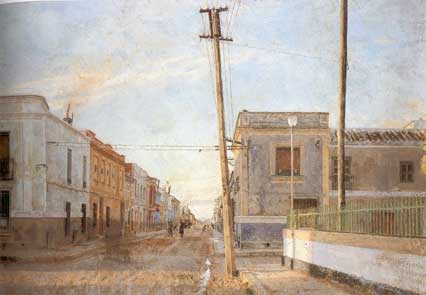
Street of Santa Rita, oil on canvas, 1961 by Antonio Lopez Garcia.
Accessed from http://www.artelibre.net
This morning’s post for Return to Our Senses in Lent is contributed by C. Christopher Smith. He is the editor of The Englewood Review of Books, and author of several books, including most recently The Virtue of Dialogue: Conversation as a Hopeful Practice of Church Communities (Patheos Press 2012). He is presently in the process of writing a book entitled Slow Church (co-written with John Pattison, forthcoming from IVP Books). Chris and John blog about Slow Church on the Patheos Interfaith portal.
“[Hope] to belong to your place by your own knowledge /
Of what it is that no other place is…” – Wendell Berry
I was deeply moved by the story of the Spanish painter, Antonio López García, as it was told by art critic Daniel Siedell in a recent Books and Culture review:
For most of us, the world is no longer a cause of fascination, of sustained contemplation and reflection. A bird is just a bird, a vase of flowers just that, and the grace of this man or the charm of that woman is buried beneath a multitude of judgments we make about them as they pass us. This is the “real world,” the world in which as Cervantes writes, an inn is just an inn. …
One of the more remarkable and stubbornly beautiful and seductive objects in the world for López García is the quince tree in his backyard. For decades he has tried to paint this simple tree as it absorbs and refracts the sunlight. In 1992 filmmaker, Victor Erice was given unique access to the artist’s world to make the award-winning documentary El Sol del Membrillo (The Quince Tree of the Sun). The film tells the story of López García’s approach to art through his relationship with this little tree, which he feels the urge to paint every autumn. And yet every autumn it thwarts his attempt to capture his experience of it.
In a similar way, I have for several years now been getting to know my own immediate urban neighborhood in Indianapolis, an undertaking that I like to call urban naturalism. Inspired by the poetry of early twentieth century agrarian Liberty Hyde Bailey, I walk the streets and paths of the neighborhood, take pictures, climb trees, look, listen and often write. Our Englewood neighborhood is a postage stamp of a place, about twelve blocks in all, sandwiched between two abandoned industrial complexes that have sat idle for about two decades. Our ZIP code also has one of the highest rates of abandoned housing in the nation. By practically any measure, Englewood is what the new monastics would call “an abandoned place of empire.”
And yet, the life of God abounds in this place (as in all places). Treetops are full of all manner of birds, insects and mosses; fiesty, bright yellow dandelions emerge through cracks in the pavement; even when things made be human hands start to crumble, the life of creation rolls vibrantly on. And the life of creation is a superabundant gift of god for us to see, smell, feel, hear and maybe even taste. Certainly, we need the wisdom of time and others. Not every plant was made to be eaten, or even touched, for instance. Being able to identify birds, plants and trees, can help us to care for them better, or to know when something is awry – say, when we encounter a bird or an animal that is not native to our place.
As we come to know our places, and belong to and love them, we make ourselves available for the healing love of God to flow through us to our neighbors and the other creatures who share this place with us. We strive to live carefully on the land, and cultivate it in ways that sustain us and our neighbors (e.g., growing food), and engaging in the economy and built environment of the place in a way that moves the place forward ever so slightly toward health and flourishing. But to submit ourselves to God’s all-encompassing work of reconciliation in this way takes discipline. We have to slow down, be still and receive the rich gifts that God wants to offer us. Our fast food world does not make this easy for us. Lent is a season in the church year in which we learn to discipline ourselves, not for our own sake but for that of the common good. I’m not a very disciplined person; even in my urban naturalism efforts, I am often too busy with my work to do much at all.
We need discipline. We need seasons like Lent that help us look beyond ourselves and our busyness and by belonging to our places to grow in our love for God and for God’s creatures that share our place with us. God help us. May your kingdom come on earth as it is in heaven!
——–
C. Christopher Smith is the editor of The Englewood Review of Books, and author of several books, including most recently The Virtue of Dialogue: Conversation as a Hopeful Practice of Church Communities (Patheos Press 2012). He is presently in the process of writing a book entitled Slow Church (co-written with John Pattison, forthcoming from IVP Books). Chris and John blog about Slow Church on the Patheos Interfaith portal.

1 comment
Very nice post. I just stumbled upon your blog and wanted to say that
I have truly enjoyed surfing around your blog posts.
In any case I will be subscribing to your rss feed and I
hope you write again very soon!